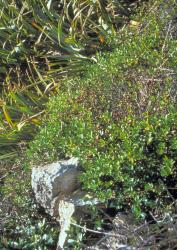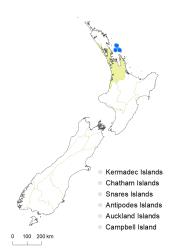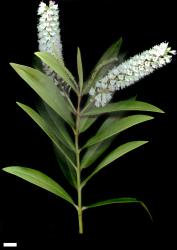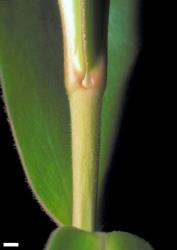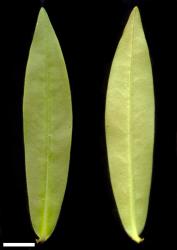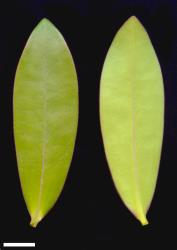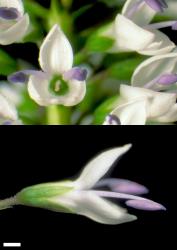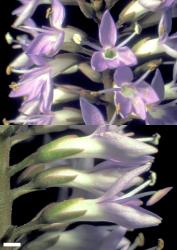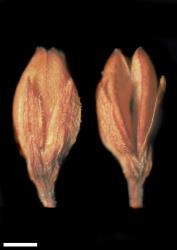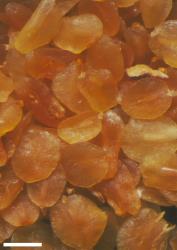- ≡ Hebe pubescens subsp. sejuncta Bayly & de Lange in Bayly et al., New Zealand J. Bot. 41: 42 (2003)
Bushy shrub, often heavily branched, to c. 1.6 m tall. Branchlets glabrous or uniformly minutely puberulent. Leaf bud sinus usually conspicuous, sometimes (Mokohinau Is.) very small, rounded to sub-acute. Leaves obovate, oblanceolate, or narrowly elliptic, sub-coriaceous to firmly coriaceous, 30–125 mm long, 7–31 mm wide, dark to very dark green above; midrib beneath glabrous or pubescent with hairs <0.2 mm long; surface beneath glabrous; margins sparsely ciliate to pubescent or sometimes glabrous. Inflorescence 55–145 mm long. Calyx lobes glabrous or hairy on outer surfaces. Corolla tube 2.5–5.5 mm long; lobes glabrous, ciliate, or hairy on outer faces. Ovary and capsules sparsely hairy, especially along septal grooves, or glabrous; capsules 4–6 mm long.
Two other hebes, V. macrocarpa and V. stricta, occur on Te Hauturu-o-Toi / Little Barrier I. and the Mokohinau Is. V. bollonsii occurs nearby on the Hen and Chickens Is.
Plants of V. macrocarpa lack a leaf bud sinus and their flowers have rounded corolla lobes. In these localities they have narrower leaves than plants of V. pubescens subsp. sejuncta, their calyx lobes are brownish and rounded, their corollas are violet with rounded lobes, and the stamens are long-exserted.
Plants of V. stricta lack a leaf bud sinus and tend to have smaller flowers with shorter, narrower, and more erect corolla lobes. The leaves of V. stricta are much thinner and softer than those of V. pubescens subsp. sejuncta.
V. bollonsii is quite similar to V. pubescens subsp. sejuncta in its leathery, obovate leaves and its flowers, but it differs in its lack of a sinus in the leaf bud. In spite of this similarity, subsp. sejuncta has a very similar flavonoid profile to other populations of V. pubescens and this supports its placement here (Bayly et al. 2003; Bayly & Kellow 2006).
North Island: Auckland (Te Hauturu-o-Toi / Little Barrier I., Mokohinau Is., and a single collection from Great Barrier I./Aotea I., identified as this subspecies by Bayly et al. 2003).
Coastal scrub and Phormium herb-field, cliff faces, rock outcrops, rarely in open disturbed sites within Metrosideros excelsa / Nestegis apetala forest. Recorded elevations range from 0 to 280 m.
Flowers: all year; fruits: all year.
2n = 40 (see Bayly & Kellow 2006, as Hebe pubescens subsp. sejuncta).
Specimens from Te Hauturu-o-Toi / Little Barrier I. have corolla tubes 2.5–4.0 mm long, lobes 2.3–5.5 mm long, and capsules 3–5 mm long. Specimens from Mokohinau Is. have corolla tubes 3.0–4.5 mm long, lobes 3.5–5.5 mm long, and capsules 4.3–6.0 mm long.



